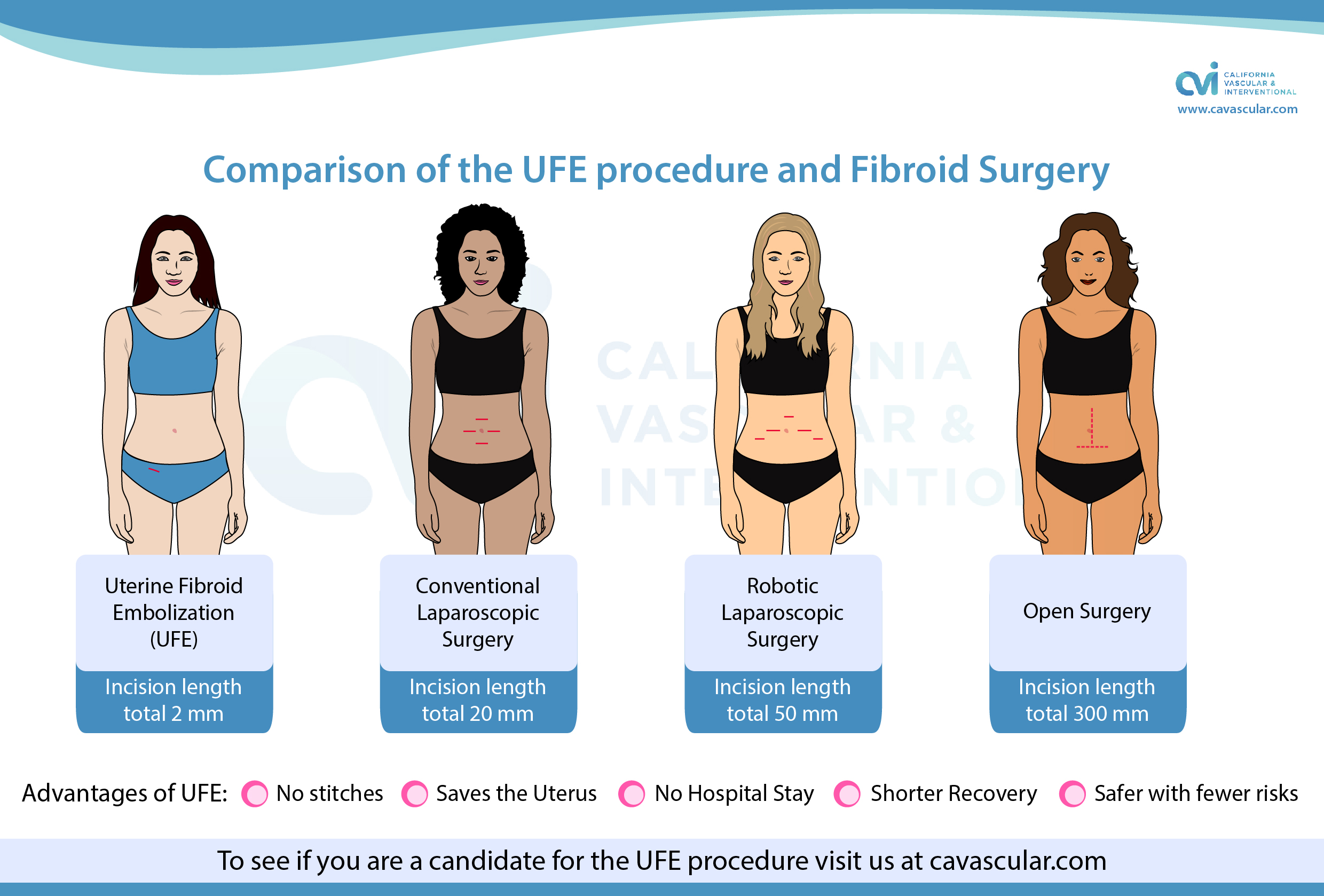
Virtual remote appointments are available. Contact us for a video telehealth evaluation.

All appointments conducted by our Board Certified doctor and not assistants or non-physician providers.

Myomectomy vs Hysterectomy vs Fibroid Embolization Scars
There are different treatment options for fibroids, surgical options require larger incisions and carry different risks than fibroid embolization. Below is a brief description of myomectomy surgery, hysterectomy surgery and fibroid embolization.
Myomectomy
Myomectomy is the surgical removal of one or more fibroids and it can be quite complex. Usually there are more fibroids than can be safely removed through this surgery and so fibroids can be left behind. As a results, these patients unfortunately frequently undergo multiple procedures.
Myomectomy is done in the hospital under general anesthesia. This can be performed through a large abdominal incision, an open myomectomy, or through multiple smaller incisions as a laparoscopic myomectomy. Open surgery involves a single 4 inch incision also known as the “bikini cut" and the laparoscopic approach would require and leave behind several 1 cm incision scars.1
Hysterectomy
A hysterectomy is a major surgical procedure performed in the hospital or surgery center under general anesthesia. The doctor may also remove the fallopian tubes, ovaries and/or the cervix during the same surgery.
This surgery can be performed as an open hysterectomy, vaginal hysterectomy, and a number of laparoscopic techniques. An open method leaves a 4 inch incision scar in the lower abdomen, and takes the longest time for recovery. A laparoscopic hysterectomy involves several 1 cm incisions and requires inflating the abdomen with carbon dioxide so that the uterus can be seen with a camera during the removal. Large fibroids or a big uterus cannot be removed this way and will be done by open hysterectomy.2
The disadvantages of abdominal hysterectomy are that due to the invasiveness of the procedure the surgery requires general anesthesia, and has risk factors associated with abdominal surgery such as blood loss, pain and infection, and longer recovery. The hospital stay can last from 1-3 days and recovery time is generally 2-6 weeks.
Uterine Fibroid Embolization
UFE is not a surgical operation. Uterine fibroid embolization (UFE) is a minimally invasive outpatient procedure that is highly effective for treating uterine fibroids and adenomyosis while preserving the uterus. Under conscious sedation, UFE begins with a single nick in the arm or groin about 0.2 cm long. A slim, flexible tube called a catheter is inserted and guided to the uterine arteries. Tiny particles the size of sand are then placed through the catheter, which pass into the vessels that supply fibroids blocking the blood flow.
Our specialist is an embolization expert and has successfully performed numerous complex embolizations and over 5,000 image guided procedures. In addition, he has extensive experience in performing this procedure through the arm, which patients love as it is more comfortable and preserves modesty.
How does uterine fibroid embolization compare?
Lower Risks: UFE is less invasive. Unlike surgery, there is virtually no blood loss during the UFE procedure. Studies show the rate of complications after UFE is significantly lower than that related to surgery.3
Effective: UFE is just as safe and equally effective. A study that compared 149 UFE and 60 myomectomy patients and found similar improvements in symptoms following treatment. Nearly 90% of women report that they are satisfied with the UFE procedure or remain free of fibroid symptoms 2 years after and a similar percentage of women report that they are still happy with their results 5 years after treatment.4 In comparison, rate of fibroid recurrence five years post-myomectomy can be up to 62.1%.3 UFE was also found to have required fewer days off work (10 versus 37 days) and fewer complications (22% vs 40%).5
Shorter Recovery: UFE uses image-guidance and not surgery. Abdominal myomectomy requires hospitalization and up to 6-8 week recovery period. After the UFE procedure you go home the same day with just a Band-Aid. Recovery time differs but in general lasts less than a week after UFE.
Make sure you understand your options and the surgical risks before agreeing to any procedure. Our vascular embolization expert sees patients in person and via virtual telehealth throughout California including Los Angeles, Inland Empire, San Diego and Orange County.
Patient Centered. Dedicated. Comprehensive.
References:
1. Rakotomahenina, H., Rajaonarison, J., Wong, L., & Brun, J.-L. (2017). Myomectomy: technique and current indications. Minerva Ginecologica, 69(4), 357–369.
2. Shiber, L.-D. J., & Pasic, R. (2018). Choosing the Correct Hysterectomy Technique. In I. Alkatout & L. Mettler (Eds.), Hysterectomy: A Comprehensive Surgical Approach (pp. 143–147). Cham: Springer International Publishing.
3. Memtsa, M., & Homer, H. (2012). Complications associated with uterine artery embolization for fibroids. Obstet Gynecol Int. 2012: 290542.
4. Gupta JK, Sinha A, Lumsden MA, Hickey M. Uterine artery embolization for symptomatic uterine fibroids. Cochrane Database of Systematic Reviews 2014, Issue 12. Art. No.: CD005073.
5. Goodwin SC, Bradley LD, Lipman JC. UAE versus Myomectomy Study Group. Uterine artery embolisation versus myomectomy: a multicenter comparative study. Fertil Steril 2006;85:14–21
Contact California Vascular & Interventional today to find out if you are candidate for uterine fibroid embolization.
